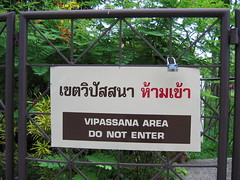Okay, caught your attention (did you see what happened when you read this headline)?
Now, let me rephrase a bit: This post is about how a Vipassana-opponent turned into a Vipassana-proponent. Interested? This is the story:
If you were raised in the West and got to know Buddhism from a scientific background and tradition-teacher-critical mindset (think Kalama Sutta) your premise of uncovering Nibbana in this lifetime would read like this:
First of all, I am only interested in what Buddha taught. Where can I find out what he taught? What is the most authentic and most original representation of his teachings/discourses going back to his time? Let me start my praxis and understanding from there, rather than through third class secondary literature or contradicting contemporary interpretations.
Obviously, your focus would then fall on the texts of the Sutta Pitaka of the (Theravadin) Pali Canon, the most ancient surviving (textual) tradition encapsulating the words of the Buddha.
Now, if you start reading those texts in any modern translation, you will come to the conclusion, that Buddhist meditation is all about (based on morality, of course) attaining jhanas, or deep concentration states of the mind. You believe that wisdom will come on its own. And your favorite Dhammapada verse would sum that idea up like this:
“Natthi jhanam apannassa / panna natthi ajhayato
yamhi jhananca panna ca / sa ve nibbanasantike.”
“There is no meditation for him who is without wisdom;
there is no wisdom for him who is without meditation.
Nearer to Nibbana is he, in whom meditation and wisdom meet.” (Dhp 372) and (here)
Your next step however involves finding other people practicing on the path. Then, looking around, you hear people talk and write about vipassana. Vipassana? That is not even mentioned once(*) in the suttas, what is that? You read about vipassana and find out that it originated (at least in its modern revived practice) in Burma in the country of Abhidhamma, propagated by monks who learn and love the late abhidhammic scholasticism and commentaries…Those parts of the Buddhist canon, which you know from historical and text critical studies to be the least reliable teachings. At least that is what you conclude.

As an outspoken and tradition-critical Buddhist you get into arguments with other people who are so enthused about their latest vipassana retreat. It is true, your own attempt at getting into jhanic states (or deep concentrations states) is cumbersome and slow. You cannot understand why these other vipassana “junkies” would be able to progress on the path of the Dhamma, if they have not even undertaken some training in concentration meditation – let alone practice only “dry vipassana”. “Yikes”, you think. You try to tell them that their practice is wrong. Or will not bear fruits, because, what they do is neither explained nor legitimized in the most ancient Buddhist texts, or is it?
If you happen to be in Thailand or a Thai related tradition, your pretence against vipassana could be worse. For whatever reason (jealousy towards their little under-developed Northern neighbour?) Thai meditation masters are known for their struggle with wild tigers in jungle infested regions as part of their zen-like adventurous struggle towards nibbana. But they are not known for systematic meditation methodologies. Especially not in vipassana training.
If you happen to be in Sri Lanka, arguments are found for both meditation approaches. Chances are you find people on both sides of the argument, however, in recent decades, the majority definitely turned in favor towards (Burmese-style) vipassana. In the Western world, despite groups of people in favor of jhana meditation (usually among the few who DO study the pali canon) vipassana rules the day. However, the closer someone professes to have studied the most authentic pali suttas they will show reluctance to except vipassana meditation. Reason: It looks like its not mentioned in the texts, or is it??
Here you might find yourself in a peculiar situation. Are the early texts wrong and the many people vouching for vipassana right? Or are they missing a crucial part and the suttas correct in that jhana is needed first before attempting vipassana or insight meditation?
Let me show you how to solve this (apparently) difficult problem. For that matter, let us imagine a personal story:
 From whatever karmic reason, being a stern vipassana sceptic (probably not for the first time), trying to carefully navigate between the past and present views about the Dhamma, and in order to find the authentic path and achieve Nibbana in this very life, you come in contact with a very active, highly trained meditation group. They teach jhanas and vipassana. However, they won’t teach you the jhanas. Not yet.
From whatever karmic reason, being a stern vipassana sceptic (probably not for the first time), trying to carefully navigate between the past and present views about the Dhamma, and in order to find the authentic path and achieve Nibbana in this very life, you come in contact with a very active, highly trained meditation group. They teach jhanas and vipassana. However, they won’t teach you the jhanas. Not yet.
Why? What is their argument?
You don’t need full jhana concentration to start doing vipassana. (You keep your doubts to yourself). You don’t know your time of death! (Sure, granted). Are you willing to risk death and thus loose this special samsaric opportunity to gain insights into the nature of your mind just because of some desire for deep concentration states? You think: I can show you dozens of passages which will highlight the importance of strong concentration before insight can be born. But lets say you agree to the challenge and keep your scepticism to yourself. They invite you for a 20 day retreat. Let the practice and its results be your guide, they say. Not theory. Not texts. Not tradition. So, in the true spirit of the Kalama Sutta you start the work.
So interestingly enough as soon as you agree, (this being a proper place) …. You are taught the basics in concentration meditation…(as I said, we imagine a very good systematic place)…Every meditation session includes a reflection on your sila (virtues), includes small exercises in concentration and eventually applies a thorough vipassana methodology – without a full blown mastering of the jhanas, of course… just enough to sustain concentration for the task at hand – which is the noting of the appearing and vanishing of the six sense bases…or five groups of grasping….peeking “under the hood” of samsara. First slowly, clumsy. Then quicker and sharper. To see impermance, dukkha and emptiness of a self.
Now, as time passes, you are astonished. You find yourself walking through the commentarial vipassanāñāṇa in a personal direct experience in real-life, yet even those vipassana insights have not been discussed in the suttas, or have they?
However, you know how emphatic the Buddha was about seeing the rising and falling and the wisdom born thereof.
And yes, the further you practice vipassana in this systematic way, the more you understand how your six senses work, how concepts and thoughts are empty. What you did not believe in your wildest dreams to be true comes true. A method which seems to have originated from nowhere creates knowledge which remind you of the results the sutta speak of. However, the path you took seems not to be mentioned in the suttas. Can this be?
A huge dilemma: How in all the world can it be, that the suttas talk 90% about jhanas when they mention meditation and you don’t hear them talk about vipassana, wheras the commentaries and the working vipassana techniques (so popular nowadays) are not mentioned once?
At that point, convinced by the experience and practice of vipassana meditation you look back at the suttas. You are convinced that you need to take a closer look. Something is wrong here – and it is not your result-producing practice.
 So you go back to the pali texts and translations and try to look for an answer. Very soon you understand, that the various modern translations are the culprits in “hiding vipassana”. We could also say the commentaries, as they failed to better relate pragmatic knowledge and concepts of their times to the suttas (but, well, the Burmese example shows, some were able to figure it out reading and studying the texts close enough).
So you go back to the pali texts and translations and try to look for an answer. Very soon you understand, that the various modern translations are the culprits in “hiding vipassana”. We could also say the commentaries, as they failed to better relate pragmatic knowledge and concepts of their times to the suttas (but, well, the Burmese example shows, some were able to figure it out reading and studying the texts close enough).
Well, or we could simply acknowledge the fact, that meditation practice is hardly a matter for texts and difficult to transmit between real people in real life – even harder on the paper. So it is and always will be a challenge to convey meditation experience and practice on a page – or palm leaf.
Because, in truth, the suttas are FULL of references to vipassana, in fact theses references probably dwarf any mentioning of the jhanas by 100:1. But the word vipassana is not what one has to look for. This insight producing part of the Buddhas teaching was so central to his mission that he spoke about it almost every time someone came to him with a question. But only later in his life he started using the term “vipassana” which in later centuries became exclusively used to what the Buddha coined “sati” during his life.
So the term he is using is hardly ever “vipassana” (some suttas, mostly commentaries use this term) and not “noting” (commentaries use this term, sallakkheti).
The Buddha uses “sati – remembering” instead or he uses “yoniso manasikaro – proper attention” or he uses “iti pajanati – to know “thus” or he uses various verbs related to “samanupassati – seeing,observing” etc. etc..
Remembering/Noting/Witnessing as a function of the mind to withstand the drag of the sense impressions and to actively witness with wise attention what is going on with the help of a (small number of very specific) labels.
And the Buddha uses “iti pajanati”. He uses direct speech. He tells us what to do – in fact how to note our experience – how to use a very simple concept like “This is not mine. This am i not. This is not my self” to de-conceptualize our constantly proliferating world-experience.
But the many scholarly (and contemporary) translators (in most cases) could not recognize this. They translate “you have to see the forms as empty” when it more literally says “you have to see the form so: ‘empty’”. A tiny little change, granted, but suddenly the missing link re-appears. And vipassana is all over the place. In fact, not only that – now references of how to use sustained thoughts in helping to induce concentration meditation appear in the pali texts and even jhana meditation lightens up.
Here is another exapmle. Such an obvious pali sentence as this one
Atthi kayo’ti pan’assa sati paccupatthita hoti yava-d-eva nana-mattaya pati-ssati-mattaya
Lit.: “(There) is a body” so too his remembering/noting/attention established is, just for the sake of knowing, for the sake of awareness.
from the famous satipatthana sutta gets translated by one famous scholar monks as:
he has clear mindfulness of the existence of the body only to extent that will serve to make it an object of gnosis (ñana) and recollection.
Therefore, a more literal translation – careful towards the application of meditation practice – would show that the Buddha’s “samma sati” is in fact the commentaries favorite “vipassana”. (more on this here)
And so, the seeming contradiction between jhana and vipassana dissolves into a close link between the two. Whereas the one uses thoughts to increase concentration on an object (think: “buddho, buddho”) the other uses specific labels to aid the development of deep insight by directing/guiding the bare attention: “This is feeling”. “This is how feeling appears”. “This is how feeling vanishes”. Left alone the mind behaves like a monkey in a forest. Both, insight and concentration meditation prosper on the usage of sati, that is “remembering”.
We could make changes and say instead “sati and samadhi” if we do not like to say “samatha and vipassana”…yes, that would probably have been the terminology of Buddhist meditation at the time of the Buddha. But nothing is wrong to use the preferred commentarial terminology and say “samatha-vipassana”. After all, these are all simply names/concepts relating to a pragmatic approach in meditation. That is why the Buddha mentioned vipassana implicitely when talking about jhanas and implicitely concentration when talking about vipassana. It gets problematic if these “notions”, “thoughts”, “views” start to interfere with our practice and we avoid walking on the entire noble eightfold path.
A little add-on:
Another problem is the mistaken role of jhanas in the recent vipassana revival. Jhanas are mistaken to be a hindrance or annoyance to the insight meditator. Very often jhanic states deriving from the intense “noting” practice are not acknowledged as such and lead to confusion. Someone with prior training in concentration has an easier time gauging his experiences (and continuing to note) by-products of a deep concentration. Therefore, the so-called “upacara” samadhi or “access” concentration is many times the result of a concentrated meditator untrained in the mastery of the jhanas. This will lead to jhanic experiences which then appear random and fuzzy and attract the wrong kind of attention by a vipassana meditator who never experienced them before. What could be a support due to the narrower focus of attention now turns into a hindrance, a broken and unsustained, underdeveloped jhana.
 Final note: While our criticism was primarily directed towards the Jhānapubbaṅgamāvāda(i.e. the group of people who say that jhanas have to be developed first, like this) including the hint that “directing once mind towards realization of the 4 noble truth” is where the “real” work starts 🙂 we did try to balance our constructive criticism with remarks on the importance of one-pointedness. Vipassanāparāmāsāvāda (i.e. the group of people who separate vipassana from morality and concentration and place it above all) are in danger of dancing on the same spot and slowing down their progress. Khanika or ‘momentary’ concentration in this regard is an oxymoron, in my humble opinion. Think about it.
Final note: While our criticism was primarily directed towards the Jhānapubbaṅgamāvāda(i.e. the group of people who say that jhanas have to be developed first, like this) including the hint that “directing once mind towards realization of the 4 noble truth” is where the “real” work starts 🙂 we did try to balance our constructive criticism with remarks on the importance of one-pointedness. Vipassanāparāmāsāvāda (i.e. the group of people who separate vipassana from morality and concentration and place it above all) are in danger of dancing on the same spot and slowing down their progress. Khanika or ‘momentary’ concentration in this regard is an oxymoron, in my humble opinion. Think about it.
A proposal for today’s Theravada practice therefore, could look like this:
Our practice needs to establish a balance between sila, samādhi and paññā . One possibility is to incorporate reflection on sila and preparation on samathā into a preamble for every vipassanā meditation session. In fact there are such integrating and systematic approaches out there (esp. in Lanka) and if this post serves any good it might do some advertisement for such comprehensive approaches to Buddhist training.
“Now what is concentration, lady, what is its topic, what are its requisites, and what is its development”
“Singleness of mind is concentration, friend Visakha; the four foundations of sati are its topic; the four right efforts are its requisites; and any cultivation, development, & pursuit of these qualities is its development.” [Dhamma Dinna in MN 44]
—Footnotes—
(*) The term vipassana is already mentioned and used in the suttas albeit not very common. Mostly in conjunction with samatha-vipassana but most of the passages which do mention vipassana in the suttas could be from younger text strata. I have another post in my draft folder with some quantification on this topic which i will link to at this place once it’s posted.






18 comments